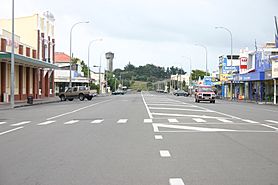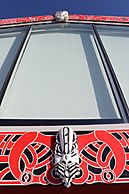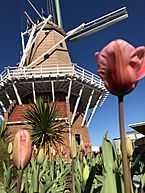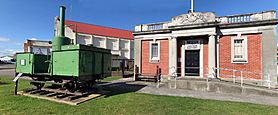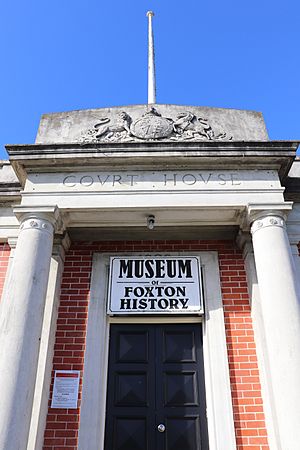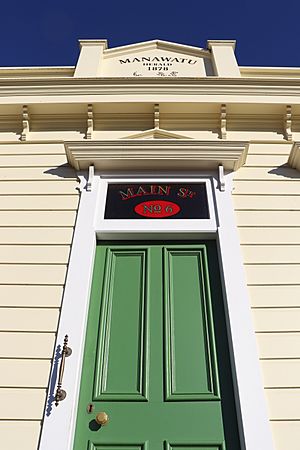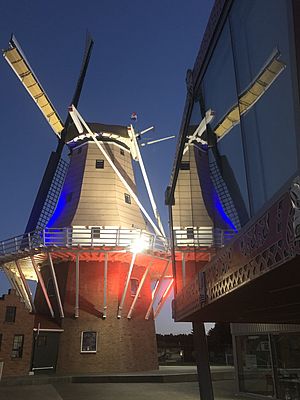Foxton, New Zealand facts for kids
Quick facts for kids
Foxton
Te Awahou (Māori)
|
|
|---|---|
|
Town
|
|
|
From top, left to right: Main St Foxton, Te Awahou Nieuwe Stroom, De Molen Windmill, Court House Museum
|
|
| Country | New Zealand |
| Region | Manawatū-Whanganui region |
| Territorial authority | Horowhenua District |
| Ward |
|
| Community | Te Awahou Foxton Community |
| Named for | William Fox |
| Electorates |
|
| Area | |
| • Total | 10.57 km2 (4.08 sq mi) |
| Population
(June 2023)
|
|
| • Total | 3,380 |
| • Density | 319.8/km2 (828.2/sq mi) |
| Postcode |
4814
|
| Area code(s) | 06 |
Foxton, also known as Te Awahou (in Māori), is a town in New Zealand. It is located on the lower west coast of the North Island, in the Manawatū-Whanganui region. The town sits near the Manawatū River and is on State Highway 1. It is about 30 km southwest of Palmerston North.
The smaller coastal town of Foxton Beach is considered part of Foxton. It is located about 6 km to the west, right on the Tasman Sea coastline.
As of June 2023. , Foxton had a population of 3,380 people.
Foxton has a rich history, celebrating both Māori and European (Pākehā) cultures. You can explore this history through its parks, old buildings, and four museums. The Manawatū River Loop and estuary are home to Ramsar wetlands, which are special areas for nature. These wetlands are a great place to see many different kinds of birds, with 93 species recorded.
Contents
Foxton's Changing Story
Foxton was once a busy town known for its flax mills. About 50 flax mills used to operate here, but they slowly closed down before World War II. The Feltex carpet factory also closed in 2008, which led to job losses. The town, which was once focused on industry, had to find new ways to grow.
A New Focus on Visitors
Today, Foxton is working to create a new economy by attracting visitors. You can find several cafes and unique shops along Main Street.
One popular spot is De Molen, a Dutch windmill, which welcomes about 45,000 visitors each year. The Te Awahou Nieuwe Stroom is another big attraction. This cultural and visitor center brings in around 150,000 people annually.
Te Awahou Nieuwe Stroom: A Cultural Hub
The Te Awahou Nieuwe Stroom building is a key part of the Cultural Park. In 2018, it won a top "excellence" award for museums. Inside, you'll find the Piriharakeke and Oranjehof museums, a gallery, and special exhibits. These places help visitors learn about their own heritage and family roots.
Te Awahou Nieuwe Stroom celebrates diversity with its multi-cultural and multi-lingual spaces. It also offers learning areas, including a library, a heritage room, and a children's area with educational toys.
Fun at Foxton Beach
If you enjoy an active lifestyle, Foxton Beach is the place to be. The Department of Conservation says that the Manawatū Estuary, near Foxton Beach, is one of the best places in New Zealand for bird watching. This is because many different wading and shore birds visit the area. Foxton Beach is also a popular spot for swimming and fishing. During summer weekends and public holidays, the Foxton Surf Life Saving Club patrols the beach to keep everyone safe.
Foxton's Early Beginnings
The first people to live in the Manawatū area were Māori. They likely arrived in the 1200s or 1300s. The area was not as crowded as other parts of the North Island. However, there were important Māori settlements, including a large marae at Matakarapa, across the river from Te Awahou (which is now Foxton). There were also kāinga (villages) and pā (fortified villages) along the river.
Over time, different Māori tribes lived in the area. By the 1800s, the Rangitāne tribe was present. Later, the Ngāti Toa and their allies moved in. In the 1840s, the Ngāti Ngarongo and Ngati Takihiku tribes, led by Ihakara Tukumaru, lived at the site that would become Foxton.
Foxton is the oldest European settlement in the southern Manawatū. However, it was not the very first. The first European settlement was Paiaka, located further east near the town of Shannon, established in 1844. After a big earthquake in 1855 largely destroyed Paiaka, settlers moved downstream to Te Awahou. This settlement was renamed "Foxton" in 1866.
In its early European days, Foxton was a very important trading post and shipping port. The easiest way to move goods and people to the Manawatū region was by sea. The Manawatū River was the main route into the rich inland areas. The lower North Island's west coast doesn't have many natural harbours. Foxton's harbour had a dangerous sandbar at the river mouth, but it was still used because it was the only real harbour between Whanganui and Wellington.
Foxton's History
Foxton's importance as a port began to decline when the railway line between Palmerston North and Wellington was built. The government originally planned for Foxton to be on the main railway route. A tramway linking Foxton and Palmerston North was even upgraded into the Foxton Branch railway in the 1870s.
However, there were delays in extending the line further south. Because of this, a group of Wellington businessmen built their own railway, the Wellington and Manawatu Railway (WMR). This new line took a more direct route that bypassed Foxton. When the WMR opened in 1886, Foxton's status as a port suffered. Its position worsened even more when the WMR became part of the national rail network in 1908. The railway to Foxton finally closed in 1959, leaving only road access to the town.
Flax Industry Booms
New Zealand Flax (Phormium tenax) was very important to Foxton's growth. Foxton was known as a "flax town." Its flax product was sent overseas and used worldwide as a substitute for manila.
The first traders in Paiaka and Shannon mainly traded for flax from the Māori people. This flax was then sent to Sydney. The first big flax boom started in 1869 and lasted for four years. During this time, 22,000 tonnes of flax fibre passed through Foxton's port. In the late 1880s, there was another short flax boom. This briefly helped Foxton grow again and become a busy port.
A third flax boom began in 1898 and lasted the longest. This led to more shipping, with over 10 steamers visiting regularly. By 1903, the Moutoa Estate was developed to provide the main supply of flax. However, by 1908, problems with river silting and ships getting stuck on the sandbar meant that coastal shipping started to avoid Foxton. By 1916, only two ships were coming into the port, but even then, 97,000 bales of flax were shipped out from Foxton.
The Whirokino Cut
Some people think the Whirokino Cut caused Foxton to stop being a port. However, the dangerous sandbar and constant silting were already causing problems. By the time the Cut was finished, most ships were already avoiding Foxton. (By 1942, Foxton had already stopped working as a port.)
In the late 1800s, cutting down trees in the inland Manawatu District led to more flooding. This caused the creation of stopbanks, floodgates, and the Whirokino Cut. The Cut was completed in 1943 as part of a flood control plan. It was meant to be a spillway for floodwaters. However, an unexpected flood broke through its upper end and changed the river's path down the spillway. This cut off the Foxton loop of the river, causing a lot of upset at the time. The Ministry of Works said this was accidental, but some residents believed it was done on purpose. The Foxton Loop now only has a tidal flow and is not connected to the river at its top end. The upper end of the Loop became filled with silt during a flood in 1953.
Climate and Weather
Foxton is located in a sandy area with a mild climate. Average monthly temperatures range from 8°C in July to 17.4°C in January. The lowest temperature recorded is -4°C, and the highest is 27°C.
Foxton gets about 2,000 hours of sunshine each year. The average rainfall is about 900 mm annually. The main winds in the area come from the west-northwest. These winds have pushed sand back from the coast, creating New Zealand's largest system of moving sand dunes.
Getting Around Foxton
State Highway 1 runs right through Foxton.
The town has three InterCity buses each day. There is also a commuter bus that goes to Palmerston North at 7:05 am and returns at 5:20 pm. On Fridays, there's a special bus for shoppers going to Levin.
Cool Places to Visit
The Te Awahou Nieuwe Stroom and the Cultural Park are in the center of town. You can see the fully restored BNZ building on Main Street and the oldest cottage in the region, 'Nye Cottage' on Harbour Street, from the Park.
De Molen Windmill
In 2003, a full-size copy of a Dutch windmill called De Molen was finished and opened. This working windmill is a Stellingmolen, which means it has a platform around it. It produces stone-ground flour, which you can buy inside the mill's Dutch Deli.
Visitors can climb up three floors to see the wooden gears and parts of the mill working. This shows how traditional Dutch 17th-century engineering worked. On windy days, the miller sets the blades in motion. The miller can also give tours to explain the history of milling or just chat with visitors.
Other Fun Spots
The Foxton Fizz factory, which opened in 1918, is open for visitors to explore.
The National Museum of Audio Visual Arts & Sciences, also known as the MAVTech Museum, opened in the 1970s. It is located in a real, restored movie theatre that first opened in 1911. The museum shows how audiovisual technology has developed over time.
The Foxton Courthouse building is home to the Foxton Museum. However, it was closed for a while due to concerns about earthquake safety.
Schools in Foxton
Foxton has several schools for students of different ages.
Manawatū College is a secondary school for both boys and girls. It teaches students from Year 9 to Year 13. As of February 2024, it has 240 students.
Foxton has two primary schools for students in Year 1 to 8. These are Coley Street School, with 202 students, and Foxton Primary School, with 44 students. Both schools are for boys and girls.
St Mary's School is a Catholic primary school for students in Year 1 to 8. It is also for both boys and girls. As of February 2024, it has 18 students.


